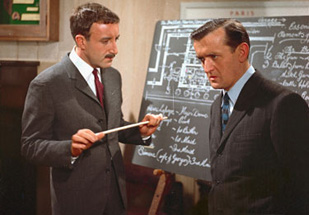|
|
Chapter Two: A Shot in the DarkBy Brett BeachSeptember 23, 2009
A Shot in the Dark was released in 1964 mere months after The Pink Panther proved to be a surprise international success, but successful in ways its creators could not have anticipated. Writer/producer/director Blake Edwards' initial intent was to follow the exploits of thief/nobleman Sir Charles Lytton (played by David Niven) through various heists across multiple continents and exotic locales. The 1963 Pink Panther is by and large a breezy relic of the early 1960s subgenre of frothy and mostly clean sex comedies set abroad and featuring a glamorous international cast. The film was rated G then and remains fairly tame today. I am not even sure if there is much in the way of innuendo, though there is a lot of door slamming and people diving under the bed before they are caught in the wrong hotel room. But a funny thing happened on the way to Lytton being the star character of the series. The world fell instead for Inspector Jacques Clouseau, the French policeman put in charge of the investigation of a series of robberies for which he (rightly) believes Lytton to be responsible. What Clouseau doesn't suspect is that his wife is Lytton's lover and accomplice. As embodied by Peter Sellers, Clouseau is a breath of the apocalypse in an otherwise genteel air. Stymied by coat racks, fireplaces, violins and couches, he is a walking klutz but never less than sure of himself, his brilliance or the fidelity of his beautiful wife (played by Cappucine). There are long stretches of The Pink Panther (one nearly 30 minutes!) where Clouseau is not onscreen and many others where Sellers seems to be restrained and one needs to be reminded that he was merely a supporting player (even though second billed) to Niven. Since a lot of this first Pink Panther is lethargically paced - a prime example being the interminable sequence where Lytton attempts to woo the woman from whom he hopes to steal the diamond - the Clouseau sequences are a welcome intervention.
|

|
|
|

|
Friday, November 1, 2024
© 2024 Box Office Prophets, a division of One Of Us, Inc.


